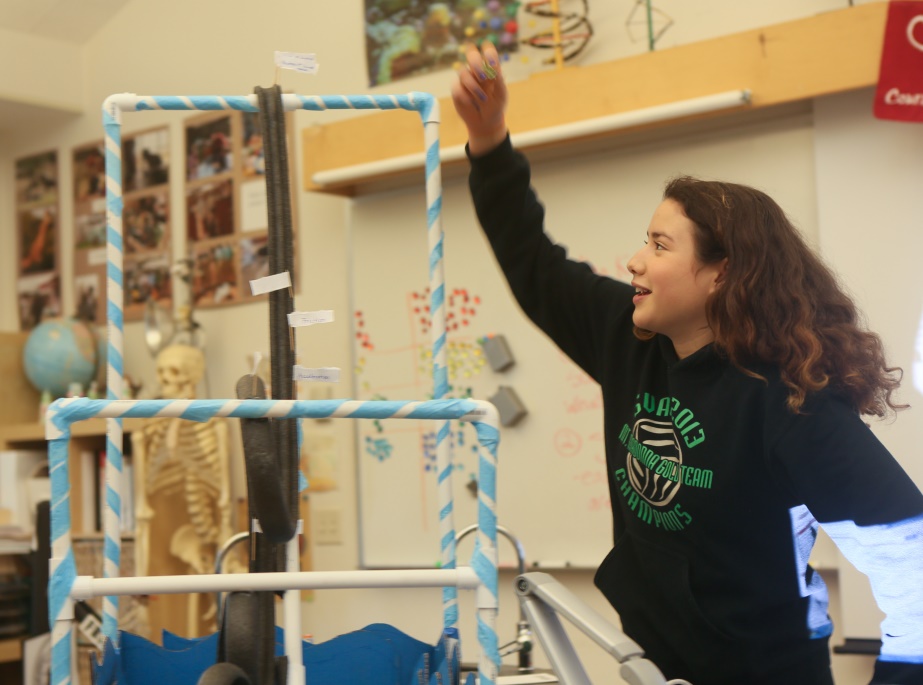
Eighth grade science at Mount Madonna School (MMS) is anything but “stationary.” The hands-on physical science curriculum engages students in a variety of projects over the course of the school year and expands their understanding of foundational concepts, an excellent preparation for the four years of laboratory science that all MMS high school students will take. On a recent morning, the classroom was full of kinetic energy, as students shared and demonstrated the model roller coasters they’d designed and built.
The types of materials students chose to create their coasters was eclectic, for sure and included: lollipops, Jell-O, SweeTARTS candy, tiny marshmallows, K’Nex, foam tubing, marbles, paper maps, wooden dowels, plywood, foam core board, multi-colored, patterned duct tape, craft sticks, toothpicks, painted cutouts of famous landmarks, paper leaves and modeling clay. Creative, as well, were the monikers students gave to their “rides:” Air Terror, Trojan Worm, Star Crafted, The Whirlpool, Sloth Coaster, and Sugar Rush among others.

The finished coaster could be no larger than a meter cubed. The models had to function correctly and incorporate many of the physics concepts the students have been learning about throughout the year: all of Newton’s Laws, centripetal force, acceleration, friction, potential and kinetic energy. Students needed to explain how their roller coaster demonstrated these concepts.
“I like to have students do the roller coaster project as it is a cumulative project on many of the concepts learned during the year,” explained their science teacher, Nicole Culbertson. “This allows students to have fun sharing their physics knowledge in an energetic and creative way, with the added element of including an original movie, skit, song or other dramatic element. They practice demonstrating physics with how their roller coasters work, and of course, designing and building their roller coasters with a variety of materials through numerous trials and error is a valuable experience. Open-ended projects help the students grasp some of the more difficult concepts learned in physics in a meaningful way.”

Students JT Curland and Given Reyhani worked together to create the Sloth Coaster. While they encountered some difficulty with the building process, the boys said their finished project came together well.
“After working on our coaster for awhile, our biggest challenge was realizing that it was lacking something and not giving up,” shared Curland. “Turning our frustration into positive energy was quite difficult, but we were able to overcome the way we felt and get back on track.”
“This project definitely helped me understand Newton’s Laws, kinetic energy and potential energy,” said Reyhani. “It helped me understand the science behind machines and rides like roller coasters, and to know what part is Newton’s first law and what part is centripetal force. I also learned a lot about how to approach projects like this in the future to try and avoid some of the challenges that we had this time.”

“I like building things,” shared classmate Noah Tervalon, who said the model construction was his favorite part of the project. “My biggest challenge was how big I was going to make it,” he added. “I intended to make it wider in both the ‘x’ and ‘y’ aspects, but I didn’t have enough energy to do what I intended, so I had to make it smaller.”
Functionality of different elements was also a consideration.
“In building my roller coaster, The Whirlpool, my biggest challenge was getting the marble to make it around the third layer of the swirl,” shared student Braeden Will. “The challenge of the swirl was to preserve as much momentum as possible during its level curling along the base. This project helped me to grasp how physics concepts affect the physical world outside of a science textbook, and the concepts were just as Nicole had explained them. My favorite part of the process was attaching my three-pound clay shark to an elevated position on the track. It was a unique experience to use something I had built so long ago for a completely different purpose.”
 The eighth graders also had a chance to share their models with the third grade class, who stopped by eager for the opportunity to see the coasters in action.
The eighth graders also had a chance to share their models with the third grade class, who stopped by eager for the opportunity to see the coasters in action.
Third graders Kadence Lewis, Madison O’Rourke and Kinsey Don Carlos stood in awe of the candy-full Sugar Rush coaster designed and built by students CeCi Rothman-Salado, Haley Kerr, Ksenia Medvedeva and Lily Hernandez.
“Wow!” said O’Rourke
“It looks like Candy Land,” commented Don Carlos.
“And it looks so delicious,” added Lewis.
Nearby, after watching the demonstrations, third grader Ian Norton-Torres smiled big.
“I saw them all,” he announced, “and they are EPIC!”

